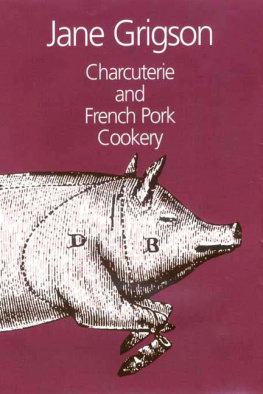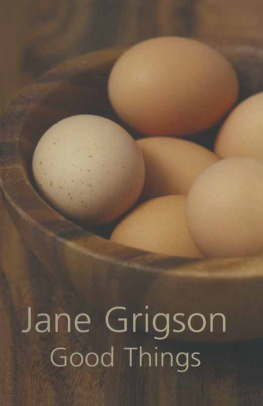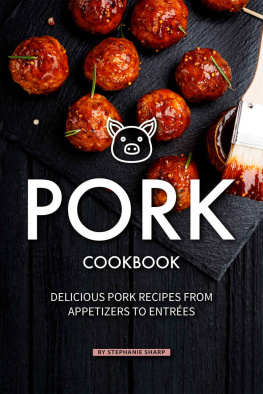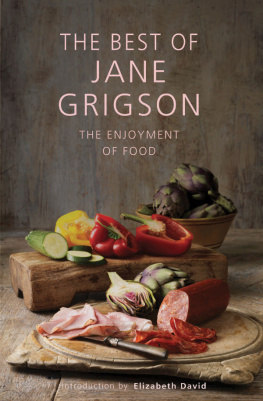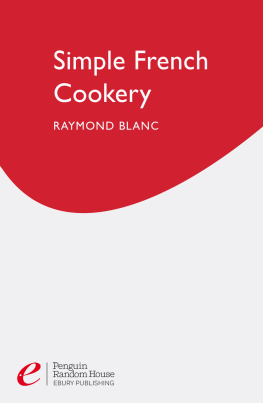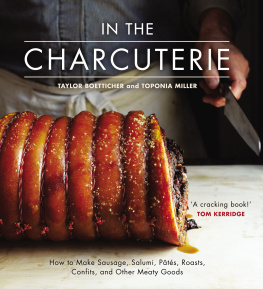

This edition published in 2001 by
Grub Street
4 Rainham Close
London SWI I 6SS
Email: food@grubstreet.co.uk
www.grubstreet.co.uk
Reprinted 2003, 2005, 2006, 2007, 2009, 2010 (twice)
Text copyright Sophie Grigson 2001
Copyright this edition Grub Street 2001
First published in Great Britain by Michael Joseph, 1967
British Library Cataloguing in Publication Data
Grigson, Jane
Charcuterie and French pork cookery
I. Cookery (Pork) 2. Cookery, French
2.1.Title
3.64l.6'64'0944
ISBN 978 I 902304 88 5
eISBN 978-1-908117-93-9
All rights reserved. No part of this publication may be reproduced, stored in a retrieval system, or transmitted in any form or by any means, electronic, mechanical, photocopying, recording, or otherwise without prior permission of the publisher.
Printed and bound in Great Britain by
MPG Books Ltd, Bodmin, Cornwall
Grub Street only uses FSC (Forest Stewardship Council) paper for its books
Introduction
I T could be said that European civilizationand Chinese civilization toohas been founded on the pig. Easily domesticated, omnivorous household and village scavenger, clearer of scrub and undergrowth, devourer of forest acorns, yet content with a styand delightful when cooked or cured, from his snout to his tail. There has been prejudice against him, but those peoplescertainly not including the Frenchwho have disliked the pig and insist that he is unclean eating, are rationalizing their own descent and past history: they were once nomads, and the one thing you cant do with a pig is to drive him in herds over vast distances.
The pig as we know him is of mixed descent. An art of charcuterie the chair cuit, cooked meat, of the pigcould hardly have been developed very far, however much people relied on pig meat, fresh or cured, as the staff of life, with the medieval pig carved on misericords, or painted in the Labours of the Months (pig-killing in November, or pig-fattening with the acorn harvest). He was a lean, ridgy and rangy beast, with bristles down his back. Two thousand years ago the Gauls in France were excellent at curing pork, and Gallic hams were sent to Rome. But what made the pig of the European styrather than the pig of the autumn oak forestsreally succulent, was a crossing of the European and Chinese pigs in England round about 1760, by the great Leicestershire stock-breeder, Robert Bakewell.
The Chinese porker was small, plump and short-legged. The European pig was skinny and long-legged like a wild boar. The cross between the two resulted in the huge pink beast of prints by James Ward of 160 years ago. Cobbett wrote that the cottagers pig should be too fat to walk more than 100 yards. Spreading through Europe, this was the creature on which French cooks got to work when the revolution turned them out of their princely, aristocratic kitchens along the Loire and in the le de France.
The trade of charcutier goes back at least as far as the time of classical Rome, where a variety of sausages could be bought, as well as the famous hams from Gaul. In such a large town slaughterhouses, butchers and cooked meat shops were necessarily well organized to safeguard public health. This system was still being followedafter a fashionin medieval Paris, although in the later Middle Ages a great increase in cooked meat purveyors put an intolerable strain on such control as there was. From this insalubrious chaos the charcutiers emerged and banded together, by edict of the king in 1476, for the sale of cooked pork only, and raw pork fat. But they did not have the right to slaughter the pigs they needed, which put them at the mercy of the general butchers until the next century. At the beginning of the seventeenth century charcutiers gained the right to sell all cuts of uncooked pork, not just the fat. Now the trade could develop in a logical manner. Incidentally in Lent, when meat sales declined, the charcutier was allowed to sell salted herrings and fish from the sea.
In the larger cities of the eighteenth century the charcutier developed a closer connexion with two other cooked meat sellersthe tripier who bought the insides of all animals from both butcher and charcutier and sold cooked tripe, and the traiteur who bought raw meat of all kinds and sold it cooked in sauces as ragots, either to be eaten at home or on his ever-increasing premises. Remember that for many people at all income levels the private kitchen was a poor affair, often nonexistent; everyone sent out to the cooked food shops for ready-made dishes. It was a big trade, jealously guarded, so that the traiteurs considered that their functions as ragot-makers had been usurped when a soup-maker, Boulanger, who described his dishes as restaurant or restorative, began to sell sheeps feet in sauce, to be consumed on his premises. He was taken to court in 1765 by the traiteurs, but he won, thereby gaining enormous publicity and a fashionable trade. More important still, he had broken through the closed shop organization by which the cooked food purveyors worked.
By the end of the century the guillotine had put many great cooks out of work. They soon saw the opportunities offered by the growing restaurant trade and the old cooked food trades vis--vis the more widely distributed prosperity of a new social order. The traiteur began to specialize in grand set pieces which he supplied on a catering basis to nineteenth-century bourgeois homes. The charcutier increased the range and quality of his pork products, and began to sell cooked tripe to his middle-class clients as well. Only the tripier seems to have lost in prestige, supplying poor families and shabby hotels with what Henry James described as a horrible mixture known as gras-double, a light grey, glutinous nauseating mess.
In the twentieth century all these categories have become blurred at the edges and interdependent. They have also benefited from most stringent food laws. French small-town hoteliers and restaurateurs now delight their clients with delicious preliminaries to the main course, supplied usually from the charcuterie near by rather than their own kitchens. This is where English hotels outside London are at such a disadvantage. There are no high-class cooked meat and bakery trades in this country. The chef with a small staff cannot send out for saucisses en broiche, quiches lorraines, or a good pt, leaving him free, as in France, to concentrate on his meat, fish and sauces.
Towards the end of the nineteenth century, France, like every other European country, benefited from the development of refrigeration. Nobody needed the huge pig anymore. With cold storage, mild round-the-year ham and bacon curing became possible, which meant that less fat was needed to mitigate harsh-tasting lean meat. At the same time there was a big increase in machine and sedentary occupations, which lessened peoples need for a high fat diet. So the pig grew smaller. Now his weight is watched as carefully as any film stars.
Probably the English pig is now being taken too far towards leanness, at any rate for the finer points of charcuterie. He has become too much a factory animal: we neglect his ears, his tail, his trotters, his insides, his beautiful fat and his flavour (pigs ears by the hundred thousand are fed to mink, from one of the Wiltshire bacon factories, which is a bit like feeding caviare to canaries). But with a little care and persistence the housewife can bully out of her butcher what is known as overweight pig, and for very little money she can obtain the fat parts, as well as the extremities and the offalthe basis of many of the most delicate and delightful dishes it is possible to make. The skilful and economical housewife can buy a pigs head for less than 50p; this is what she can make from itpigs ears with a is to be made from the bones.

